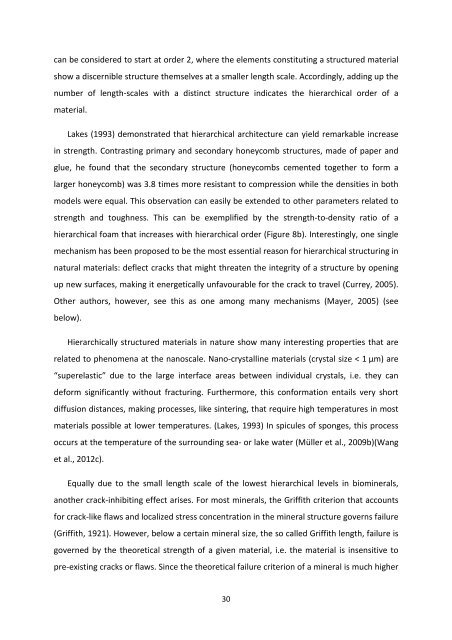MASTER THESIS Biomimetic potential of sponge ... - IAP/TU Wien
MASTER THESIS Biomimetic potential of sponge ... - IAP/TU Wien
MASTER THESIS Biomimetic potential of sponge ... - IAP/TU Wien
Create successful ePaper yourself
Turn your PDF publications into a flip-book with our unique Google optimized e-Paper software.
can be considered to start at order 2, where the elements constituting a structured material<br />
show a discernible structure themselves at a smaller length scale. Accordingly, adding up the<br />
number <strong>of</strong> length-scales with a distinct structure indicates the hierarchical order <strong>of</strong> a<br />
material.<br />
Lakes (1993) demonstrated that hierarchical architecture can yield remarkable increase<br />
in strength. Contrasting primary and secondary honeycomb structures, made <strong>of</strong> paper and<br />
glue, he found that the secondary structure (honeycombs cemented together to form a<br />
larger honeycomb) was 3.8 times more resistant to compression while the densities in both<br />
models were equal. This observation can easily be extended to other parameters related to<br />
strength and toughness. This can be exemplified by the strength-to-density ratio <strong>of</strong> a<br />
hierarchical foam that increases with hierarchical order (Figure 8b). Interestingly, one single<br />
mechanism has been proposed to be the most essential reason for hierarchical structuring in<br />
natural materials: deflect cracks that might threaten the integrity <strong>of</strong> a structure by opening<br />
up new surfaces, making it energetically unfavourable for the crack to travel (Currey, 2005).<br />
Other authors, however, see this as one among many mechanisms (Mayer, 2005) (see<br />
below).<br />
Hierarchically structured materials in nature show many interesting properties that are<br />
related to phenomena at the nanoscale. Nano-crystalline materials (crystal size < 1 µm) are<br />
“superelastic” due to the large interface areas between individual crystals, i.e. they can<br />
deform significantly without fracturing. Furthermore, this conformation entails very short<br />
diffusion distances, making processes, like sintering, that require high temperatures in most<br />
materials possible at lower temperatures. (Lakes, 1993) In spicules <strong>of</strong> <strong>sponge</strong>s, this process<br />
occurs at the temperature <strong>of</strong> the surrounding sea- or lake water (Müller et al., 2009b)(Wang<br />
et al., 2012c).<br />
Equally due to the small length scale <strong>of</strong> the lowest hierarchical levels in biominerals,<br />
another crack-inhibiting effect arises. For most minerals, the Griffith criterion that accounts<br />
for crack-like flaws and localized stress concentration in the mineral structure governs failure<br />
(Griffith, 1921). However, below a certain mineral size, the so called Griffith length, failure is<br />
governed by the theoretical strength <strong>of</strong> a given material, i.e. the material is insensitive to<br />
pre-existing cracks or flaws. Since the theoretical failure criterion <strong>of</strong> a mineral is much higher<br />
30

















